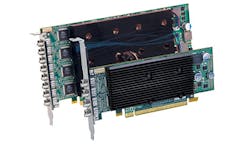Munich Airport flight information display system powered by Matrox graphics cards
MUNICH, 9 Dec. 2014. Flughafen München GmbH officials overseeing Munich Airport, the second busiest airport in Germany behind Frankfurt, sought to modernize the airport’s flight information display system (FIDS). They found their solution at InoNet, hiring the company to integrate a 72-monitor video wall driven by Matrox M-Series multi-display graphics cards.
Munich Airport serves roughly 39 million passengers annually. The original analog flight information display system (FIDS) had been in operation since the airport opened in 1992, representing arrival and departure information on multiple small LEDs. The system required a high level of IT maintenance and intervention to keep it operational. Munich Airport needed a replacement solution that could reliably display flight arrival and departure information with minimal downtime.
To deliver a high-display density canvas with pristine content, you need a high-quality graphics engine. Brought in to manage the installation, local system integrator InoNet had experience with Matrox M-Series graphics cards, which support up to eight displays from a single board at up to 2560x1600 per screen. Using a Matrox M9148 quad-monitor and M9188 octal-monitor graphics card combination within six of their Magnius-2 video wall controller systems, InoNet was able to power an astonishing 72 NEC X463UN displays, each at full HD resolutions of 1920x1080. With the display’s extremely narrow 5.7mm bezel, a user-friendly viewing angle of 178 degrees was enabled, making each of the 72 displays completely visible from any front-viewing position. IT personnel were also pleased with how the displays have been specifically configured with a fail-safe feature to ensure continuous operation.
Integrated by Inonet, Munich Airport’s 72-monitor FIDS video wall is powered by Matrox M-Series graphics cards.
The FIDS wall has a nearly 180° viewing angle making each of the 72 displays completely visible from any front-viewing position.
The Munich Airport today hosts one of the world’s largest flight information display systems in an 18x4, 72-monitor wall that spans an incredible 19 meters wide by 2.30 meters high. By switching to a digital FIDS running on a reliable video wall comprising large, Full HD displays powered by Matrox M-Series graphics cards, more flights can now be displayed in a clear, attractive form. IT staff now have taken a back seat in the day-to-day operation of the system, while passengers can quickly get to when and where they have to be.
“The aim of the installation was to present razor sharp content across the entire display. There is no scaling via daisy chaining on the 72 displays, where each monitor is individually supplied with full HD content,” says Susanne Gomez, Key Account Manager Digital Signage at InoNet. “Using the Matrox M-Series, we were able to realize the requirements quickly and easily.”
Matrox Graphics is a global manufacturer of reliable, high-quality ASICs, boards, appliances, and software for the integrators and systems builders market. The company’s product line includes: Matrox C-Series and M-Series multi-display graphics cards, TripleHead2Go external multi-monitor adapters, Maevex H.264 encoders & decoders, and Mura MPX video wall capture and display boards. Matrox hardware solutions allow professional AV installers and system integrators to confidently meet the most demanding multi-monitor requirements for any ProAV installation.
During the month-long installation, InoNet added eight additional trusses to the existing structure to accommodate all the new monitors.
Matrox M9148 quad-monitor and M9188 octal-monitor graphics card combinations are used within six systems to drive a 19 meters wide by 2.30 meters high video wall.


